THE COMMONS
For alumni and
friends
of the Nelson Institute for Environmental Studies at the University of Wisconsin–Madison


friends

How the UW Arboretum teamed up with its neighborhood to solve stormwater runoff.
The U.S. Army meets environmentalism.
Page 6
A commencement address from a Nelson graduate. Page 10
Four things you didn’t know about climate anxiety. Page 20
EDITORIAL
Kevin Berger, Graphic Designer
Anica Graney, Assistant Editor
Eric Klister, Web Editor
Chelsea Rademacher, Editor
Laila Smith, Staff Writer
Diane Stojanovich, Managing Editor
CONTRIBUTORS
Janet Bonkowski
Susan Day
Hailey Sewell Chandler Wells
DEAN’S OFFICE
Paul Robbins, Dean, Nelson Institute for Environmental Studies
Colleen Godfriaux, Interim Director of Budget and Financial Management
Anna Gade, Associate Dean for Research and Education
Diane Stojanovich, Distinguished Associate Dean for Communications
Shelly Strom, Assistant to Paul Robbins
Steph Tai, Associate Dean for Education and Faculty Affairs
Jenna Weidner, Associate Dean for Administration
CONTACT US
We’d love to hear from you! Send us feedback or questions about this issue, or share story ideas for future issues.
Nelson Institute for Environmental Studies 550 Science Hall Madison, WI 53706 communications@nelson.wisc.edu
Stay connected by updating your contact information or by joining our LinkedIn group
We’re reducing our carbon footprint! We hope you enjoy our digitally published magazine, sent monthly to Nelson alumni, students, and friends.
Experts predict an unprecedented legal battle to reign in
Nelson-led research on effective community-centered environmental outreach informs UW Arboretum programs.
The Nelson Institute hosted officers in the U.S. Army Civil Affairs and Psychological Operations Command (Airborne) for an intensive workshop on the environment.
Nelson Institute alumnus and current PhD student shared his advice with the UW–Green Bay Class of 2024.
Greetings, Nelson community,
Happy summer! (Or to those on the opposite side of the equator, happy winter!) I hope this issue of The Commons finds you well. Grab a comfortable chair and settle in, for it’s a good one.
Summer is a curious time in academia; the end of the academic year certainly brings some respite, but as you’ve likely heard me say before, the pedal stays on the metal as far as research, outreach, and collaboration are concerned — especially here at the Nelson Institute, where such things are the cornerstones of our mission.
As I browsed the lineup of stories in this month’s magazine, I was reminded just how interwoven the idea of partnership is to the Nelson Institute. We can make great starts on our own, but it’s when we come together that the real change is made. When I signed on in this job 12 years ago, the first thing I did was travel the state to visit our partners: lake associations, conservation orgs, state natural resource agents, tribes, and urban gardeners, among many others. Nelson is built on partnerships. That doesn’t change.

tween a Nelson student (now alumna); a professor who spans Nelson, CALS, and Extension; the Arb itself; and the surrounding community. Then on page 6, our resident writer puts us in the room of a brand new partnership between the university and the Department of Defense. These are people charged with restoring ecosystems, remediating soils, and rebuilding conservation apparatus in post-conflict zones; they need Nelson wisdom, knowledge, and commitment to the planet. Finally, our Universities of Wisconsin colleague Janet Bonkowski from UW–Green Bay recaps her school’s commencement address, given by none other than Nelson Institute alumnus and current PhD student, Chris Caldwell, who currently leads the College of Menominee Nation. Chris will be defending his dissertation here at Nelson soon, and we’ve learned as much or more from him than he has from us. This is the Wisconsin Idea in action, folks, and it’s what the Nelson Institute is all about.
The features section alone showcases the breadth and depth of what partnership means at Nelson. For starters, take a look at the bylines: I was excited to see three feature stories, all written by different authors across different units (and institutions)! The first story, written by Susan Day at the UW Arboretum, details a collaboration be-
And that’s just the first three stories! I hope you’re able to take some time to enjoy this issue of The Commons. As always, your thoughts and reflections are most appreciated.
 Paul Robbins Dean, Nelson
Paul Robbins Dean, Nelson
Institute

Earlier this year, a group of lawyers met with executives across the plastics industry for a frank conversation about PFAS, the “forever chemicals” that have become one of the world’s most pervasive pollutants. The group was specifically discussing potential litigation surrounding PFAS, which many experts expect could become a monumental legal battle. Steph Tai, Nelson Institute associate dean, spoke to the New York Times about some of the complexities surrounding PFAS. See more Nelson media mentions on page 16
by Jeff Miller / UW–Madison


Nelson-led research on effective community-centered environmental outreach informs UW Arboretum programs.By Susan Day, UW Arboretum
Environmental outreach can help neighbors learn to address environmental issues, such as urban stormwater, that affect their communities. Residents who are well-respected within their social networks can play a role in promoting environmentally responsible behaviors that support healthier environments.
Research led by Theresa Vander Woude, as part of her master’s degree at UW–Madison in the Nelson Institute or Environmental Studies, focused on understanding the beliefs that motivate these influential residents, or opinion leaders, and what shapes their willingness to participate in environmental outreach efforts around issues of urban water quality.
The findings suggest that it’s more important to build opinion leaders’ confidence in outreach than to persuade them about the benefits of specific conservation behaviors. The research, coauthored by Nelson Institute affiliates Bret Shaw and Karen Oberhauser, was recently published in the journal Society and Natural Resources
While influential community members may believe it is good to help neighbors change a behavior to support environmental health, that belief alone will not necessarily motivate them to get involved in environmental outreach. They are more likely to participate in an outreach effort if they also feel the desired behavior is relatively easy to adopt and if they are supported with
information and training to help them talk with people in their community.
The study provides insights about constructive ways environmental organizations can support community members in environmental outreach. And the Arboretum, which supported Vander Woude with a research fellowship, has already begun to apply the valuable findings.
Vander Woude was an Arboretum Research Fellow and a member of the program’s first cohort in 2019–20. Her research influenced Arboretum’s community engagement efforts even before it was in print.
The Arboretum is located near the lowest point of the urbanized Lake Wingra watershed and has long contended with a high volume of stormwater, which is increasing due to climate change. Nearly 500 million gallons of rainwater and snowmelt drain annually from the sidewalks, parking lots, and roofs in surrounding neighborhoods. As


stormwater drains from these neighborhoods, it carries pollutants, sediment, and excess nutrients, including petroleum products, salt, fertilizers, and trash.
The water enters the Arboretum and courses through stormwater ponds, wetlands, and drainage channels on the way to Lake Wingra. These built and natural features help clean the water before it enters the lake.

“This publication means that environmental organizations everywhere will be able to learn from our example.”
— Karen OberhauserThoughtful environmental engineering and neighborhood engagement can work together for better stormwater management. The Arboretum, along with other local agencies and organizations, have enhanced efforts to engage residents in taking actions that support cleaner water in their own yards and communities.
As part of these efforts, the Arboretum developed a grant-funded community engagement program called the WATER Project (water action to encourage respon-
sibility), funded initially by a two-year grant from the United States Environmental Protection Agency. The project included stormwater trainings for community ambassadors to support their outreach efforts, and also provided mini-grants to help groups implement neighborhood-based stormwater mitigation projects.
The WATER Project is embarking on a new phase, funded by a Wisconsin Idea Collaboration grant. The project will again offer trainings and mini-grants and will partner with Wisconsin EcoLatinos and Water Action Volunteers to broaden outreach and engagement with Spanish-speaking opinion leaders and communities.
Vander Woude’s work has provided an important foundation for research-based outreach efforts at the Arboretum, and we hope it will inform environmental outreach efforts in communities around Wisconsin and beyond. Oberhauser notes that “Theresa’s initial work ensured that we have engaged community members in effective ways, benefitting the people in the Lake Wingra Watershed and the lake itself. And this publication means that environmental organizations everywhere will be able to learn from our example.”
Vander Woude’s research was supported by the UW–Madison Arboretum and the University of Wisconsin Sea Grant Institute.
This story was originally published by the UW Arboretum.

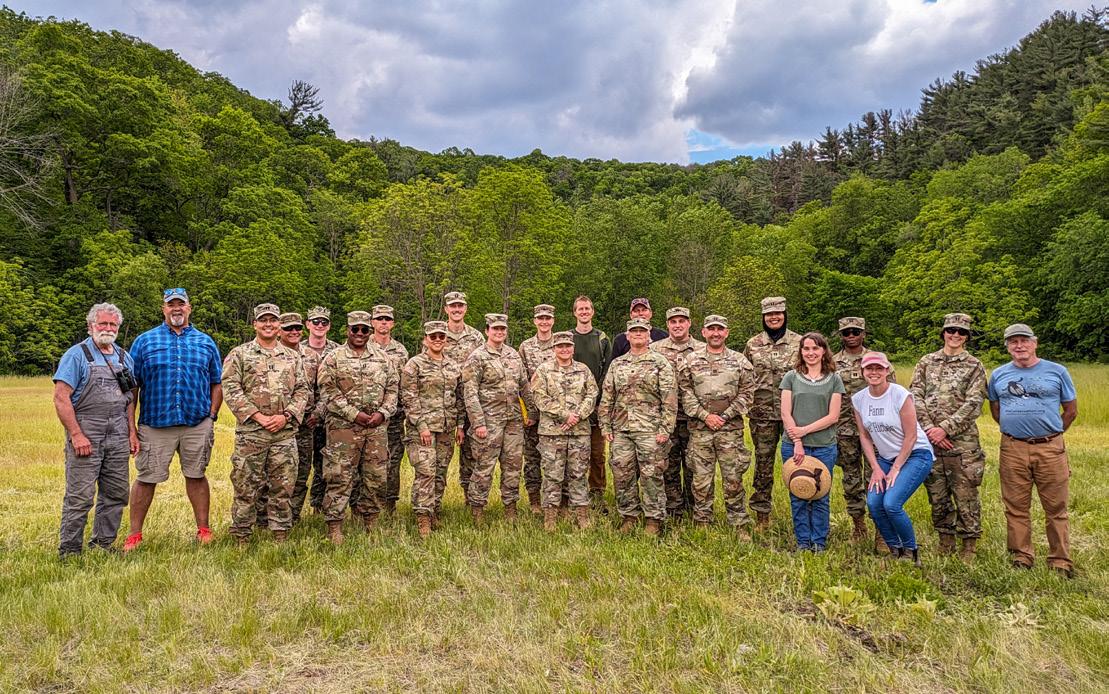
The Nelson Institute hosted officers in the U.S. Army Civil Affairs and Psychological Operations Command (Airborne) for an intensive workshop on the environment.By Chelsea Rademacher
“By equipping our service members with cutting-edge environmental knowledge, we’re empowering them to achieve mission success while promoting a whole-of-government approach.”
— Lieutenant Colonel Angela Smith
In the weeks following spring graduation, UW–Madison lulls. Dorms vacate, crosswalks idle, and classrooms empty. All is quiet on the campus front, but in Science Hall room 110, a group of 20-some folks gathered over a shared mission: learning tactics to help maintain stability in environments facing human conflict.
At 0900 on Monday, May 20, Colonel Andrew Scott DeJesse, senior heritage and preservation officer for the U.S. Department of Defense, greeted a room of lecturers and lieutenants, scientists and sergeants, outreach specialists and officers. The day began with an overview of the importance of the environment to military activities. It was the first of five days in a workshop jointly hosted between UW–Madison, the Nelson Institute for Environmental Studies, and the U.S. Department of Defense (DOD).
The workshop — U.S. Army Environmental Management for the Operational Environment — is the result of a two-year partnership between the UW and the DOD, which was signed into agreement in December 2022. “This partnership fits perfectly within our work to advance a more environmentally, economically and socially sustainable world through innovation and collaboration,” said Nelson Institute Dean
“Protecting air, water, and wildlife should be a highest priority wherever the United States is involved around the world,” Robbins said following the workshop. “The officers I met in this program are terrifically thoughtful, prepared, and well-trained; they fill me with confidence. I am enormously glad we can make this a productive partnership.”
The two-year pilot program focuses on the environmental issues regularly faced by the U.S. Army Civil Affairs and Psychological Operations Command (Airborne) and its specialist group 38G/4E, comprising officers who are subject matter experts in the environment and natural resources. “All the participants are highly motivated natural resource experts who have worked in a wide array of ecosystems and political environments across the globe. Hearing their accounts of environmental challenges and Army operations was eye-opening,” said Aly Fleming, the Nelson Institute’s director of public-private partnerships, who helped organize the workshop.
“This collaboration has really been a twoway street,” said Cooper Rosin, lecturer and outreach specialist at the Nelson Institute who had a lead role in organizing the workshop. “We’ve relished our role as environmental educators … but we’ve also learned a lot individually and institutionally through the partnership. I’ve gained a great appreciation for how the military operates, and how their very skilled personnel can make an impact tackling real environmental challenges around the world.”

When war and armed conflict happens across the globe, the losses are immeasurable. This workshop zeroed in on the environmental impacts of human conflict, from habitat alteration to air quality impacts to water supply issues. Through a mix of lectures, discussion sections, and practical exercises, UW–Madison faculty and staff across schools and colleges shared expertise in areas like community engagement, conservation management, and international laws.
“The breadth and depth of expertise at the Nelson Institute and UW–Madison was on full display for the Environmental Management for the Operational
Environment training,” said Captain Russell Martin, one of the workshop organizers from the DOD side. “The lectures we received from the respective experts in environmental governance, remediation, and conservation improved our team’s technical knowledge while also helping us develop innovative approaches to addressing some of the world’s most pressing environmental security challenges, especially those that climate change is predicted to amplify over the coming decades.”
The first day covered the human aspect of environmental management — from building partnerships to effective negotiation — led by the Nelson Institute’s Rob Beattie (teaching faculty) and Christopher Kilgour (community
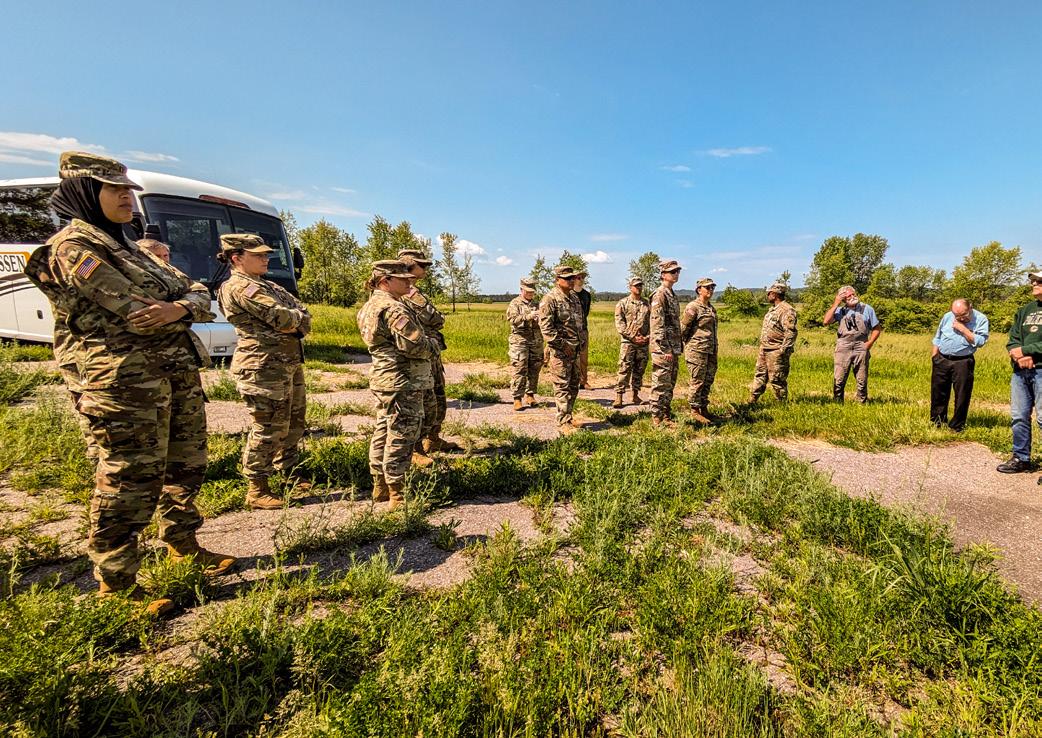
outreach manager). Day two covered broad environmental and conservation themes, including air and water quality, waste management, forest management, and conservation law. Day three then turned to resilience and change making, with experts on climate change, disaster management, and international governance.
After three days of learning in Science Hall, participants headed outside of campus for a day of on-site training. Their first stop was the Badger Army Ammunition Plant, located near Sauk City, Wisconsin, and a tour of the site’s museum with Curt Meine, museum curator and Nelson Institute alumnus and faculty affiliate. Built in 1942, this site produced munitions including smokeless powder for M-1 rifles during World War II and sulfuric acid during the Vietnam War. In 1977, the U.S. Army put the plant on “stand-by status,” where it remained until it was decommissioned 20 years later. Since then, ownership of the land has been
transferred back in parcels to the Ho-Chunk Nation, the Department of Natural Resources, and the Dairy Forage Research Center, and efforts continue to restore the land. To continue their discussion on ecological restoration and environmental mediation, the workshop continued the afternoon just north of the plant at the Aldo Leopold Shack , a National Historic Landmark where Leopold once developed his now-textbook conservation principles.
Back in Science Hall, the final day of the workshop brought all the lessons together, encouraging participants to find ways to put their new knowledge into practice. “My only complaint is that it wasn’t long enough!” remarked one participant. But after a successful first run, this workshop could just be the beginning. “Connecting with the participants in this course was rewarding and inspiring,” Fleming said. “It’s clear there are so many potential collaboration opportunities where the UW could
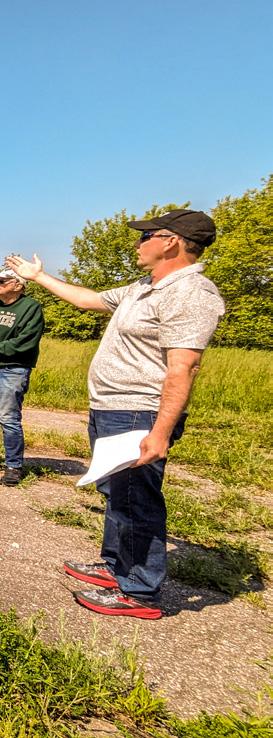

On Tuesday, May 21, experts from UW–Madison and the military led a discussion on the theme of conservation, including forest management, fish and wildlife, and conservation law enforcement. Panelists, L-R: Volker Radeloff, professor of forest and wildlife ecology in the College of Agricultural and Life Sciences (CALS); Zuzana Buřivalová, assistant professor of forest and wildlife ecology in CALS and Nelson; Nancy Foley, former California Department of Fish and Wildlife chief of the law enforcement division; and Randy Stark, Wisconsin Department of Natural Resources.
play a role in improving environmental security and lessening the environmental impact of military operations.”
“This USACAPOC-UW Nelson Institute partnership is a game-changer,” said organizer Lieutenant Colonel Angie Smith. “By equip-
ping our service members with cutting-edge environmental knowledge, we’re empowering them to achieve mission success while promoting a whole-of-government approach. This is just the beginning of a long and fruitful collaboration.”

Christopher Caldwell tells graduating UW–Green Bay students to embrace “adaptation in the face of adversity” during commencement address.By Janet Bonkowski, UW–Green Bay
What’s the best way to place value on a college education? If you ask College of Menominee Nation President Christopher Caldwell, the answer is clear. And important: “Adaption is a value not often considered when people measure the cost of education against future earnings. But, adaptation in the face of adversity and uncertainty is always needed.”

Caldwell shared his thoughts on education and the mutual commitment UW–Green Bay and the College of Menominee Nation have in creating resilient problem solvers and fearless leaders for the region. And in doing so, he says “we are honoring the legacy of this land we are on right now.” He was the afternoon speaker at UW–Green Bay’s 2024 commencement afternoon ceremony held at the Kress Events Center on the UW–Green Bay campus

Christopher Caldwell, president of the College of Menominee Nation (CMN), is an enrolled member of the Menominee Indian Tribe of Wisconsin. He has led the college since February 2020 and is the fourth person to lead CMN. He has held a range of positions at the college, including student, director, adjunct, and president. An alumnus of the college, Caldwell began his higher education here at CMN, earning his associate’s degree in sustainable development. He holds a bachelor’s degree in natural resources from the University of Wisconsin–Madison, a master’s degree in environmental science and policy from UW–Green Bay, and is currently a PhD candidate in
environment and resources from the UW–Madison Nelson Institute. During his career, Caldwell has served in previous positions focused on sustainability, specifically within the forestry sector: tribal resources director/compliance, enforcement officer for the Menominee Indian Tribe, forest products technician with the USDA Forest Service’s Forest Products Laboratory in Madison, student/intern with the U.S. Department of Interior Bureau of Indian Affairs-NCCE, timber market/forestry technician with Menominee Tribal Enterprises and more recently as the director of the Sustainable Development Institute at CMN.
Here are the full remarks he shared with the graduating class of 2024:
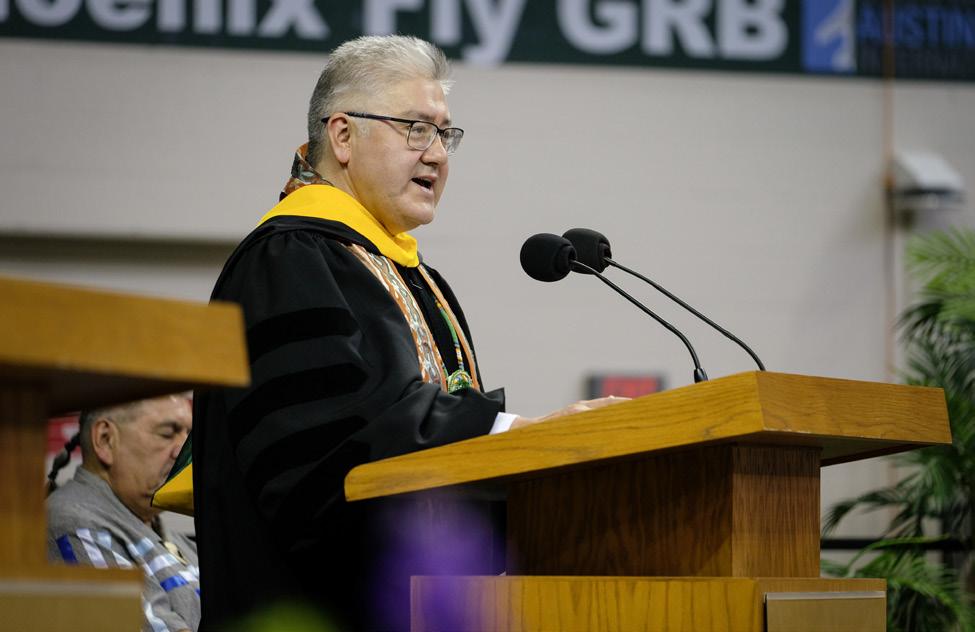
““Pōsōh nec mamaceqtawak mesek māwaw new weyak (greetings to my fellow movers and to you all). Mahkīw ahnakwat, mamaceqtaw newīhswan mesek Chris Caldwell mōhkamān newīhswan. Awāēsaeh netōtāēm awew. Kesiqnaeh, eneq’skew wekeyan.
I greet you in the Menominee language, my people’s language, which has been spoken on these lands for thousands of years.
Chancellor Alexander, thank you for the invitation to speak and for your friendship over these past few years. UWGB Board of Trustees, faculty, administration, and staff, wāēwāēnen (thank you) for everything you do to help your students succeed.
To the family, friends, and supporters, wāēwāēnen for all you have done to help your students meet their goals and for coming to celebrate with them today. For those not with us today. We keep their memories in our hearts as well.
Now, to the graduating class of 2024. In my people’s language, I say nahāw wēskewat mawaw new weyak! All of you have done an outstanding job!
Congratulations.
It is a great honor to speak to all of you today. Next week, I get to congratulate our own College of Menominee Nation graduates. But fear not; my message today is for you, my soon-to-be fellow UWGB alumni.
And so, I say, congratulations again.
Congratulations to you class of 2024, the “resilient problem solvers and fearless dreamers,” that your families, communities, and the world need today and tomorrow.
While preparing my remarks, as many speakers do, I thought about how and why I ended up in this place today, with the opportunity to serve. It’s not that I sought out this stage or the opportunity to speak. I’ve always just focused on the work in front of me, how to support my family, my community and hopefully do something I enjoy along the way …
… the same as all of you.
“Our leaders, long before my time, saw the importance of preserving and protecting as much of our lands and forests as possible for future generations to be able to make their own decisions.”
— Christopher Caldwell
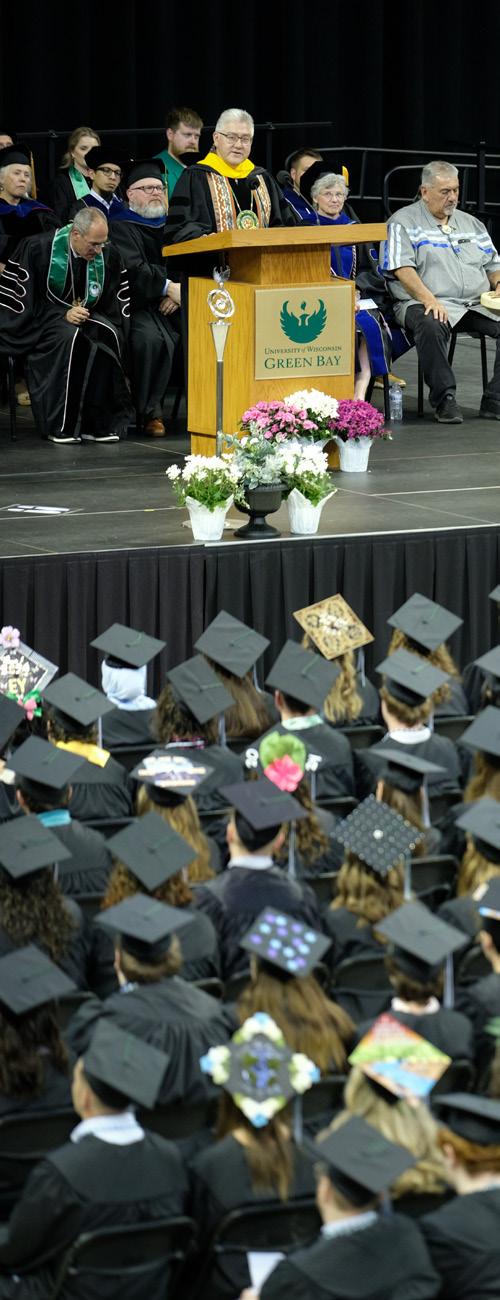
Well, as we all know, life has a way of steering us down different paths.
It probably didn’t hurt that Chancellor Alexander had to hear my bio being read at the numerous events we’ve attended together over the past few years. And one of those times he probably heard I graduated from UWGB with my masters in environmental science and policy…
By the way, if you’d indulge me for a minute. I wanted to say wāēwāēnen to the cochairs of my committee, Dr. Michael Kraft and Dr. John Stoll, who were instrumental in steering me to finish my degree at a time when I was ready to give up.
I’m sure many of you graduates know a professor or two like that here at UWGB.
I have a copy of my bound master’s thesis. Ten years later, but better late than never!
In getting to know Chancellor Alexander, the memory of our first phone call stands out the most in my mind. Although I don’t recall the specific conversation, it happened in the early days of the pandemic when we were both new leaders of our respective institutions. I remember it because I had to drive out to a dam to get a clear cell signal because our campus was closed due to the pandemic, but also a snowstorm that day.
Now, during that time, CMN had moved all our classes online and our staff to remote work within the span of a week. We didn’t have updated equipment, training, policies, or plans to do that. But we did it. I was only about a few months into my tenure, along with other interim executive leaders, and I was desperate to talk to anyone who might offer some guidance. What I found out in talking to Mike that day, was that due to the pandemic, we were all pretty much in the same boat. All we could do was our best.
That memory, along with many others from the pandemic years, reminded me that despite the obstacles that our institutions of higher education faced, we kept doing the work because of our belief in each of our institutions mission to help our students advance in meeting their academic goals, as they too navigated the pandemic and its impacts.
Many of you likely remembering your experiences and what you had to do to get by. To continue your academic journey, take care of yourself, your families, and your school and work responsibilities. All while being as uncertain as everyone else as to what would happen next.
Is it any wonder that UWGB has focused on helping to develop the next generation of resilient problem solvers and fearless dreamers?
Building the skills of people to adapt and succeed is a critical mission of our higher education institutions.
Adaption is a value not often considered when people measure the cost of education against future earnings.
But, adaptation in the face of adversity and uncertainty is always needed.
In relation to this UWGB focus on problem solving and dreaming, I want to share a short story about the Menominee experience and example …
The land we stand upon today is part of the 10 million acres of ancestral lands that the Menominee people once occupied and kept a responsibility to until the treaty era in the 1800s. Fifty years of treaty-making with the U.S. government left us with 235,000 acres of those ancestral lands. Our language was almost extinguished. Our social, economic, and cultural lifeways vastly changed. This included the loss of many people who followed dreams as a way of understanding situations and solving problems.
Yet, despite all this, our leaders, long before my time, saw the importance of preserving and protecting as much of our lands and forests as possible for future generations to be able to make their own decisions.
The result?
You can see the outline of the Menominee reservation from space because of our sustainably managed forest compared to surrounding lands that were cut over and transitioned to farmlands in the late 1800s to 1900s. Since our forest management started in the early 1900s, we have harvested the forest several times over, with more volume of standing timber now than when we started. The diversity of trees, plants, animals, insects, and other non-human relatives, waterways, and ecosystems continue to serve as the backbone of our forest’s strength and by extension, our people’s strength.
Today, a once endangered language, Omaeqnomenewaeqnesen (Menominee language), is being promoted and revitalized in tribal institutions, like the College of Menominee Nation and the K-12 school systems, in our tribal government, through grassroots organizations, in communities, in families, with individuals, and even across other higher education insti-
tutions, like the University of Wisconsin–Green Bay.
Resilient problem solvers and fearless dreamers?
The Menominee people are no strangers to those values.
And, so with the University of Wisconsin Green Bay focus, this means you as graduates of this institution, are a part of honoring the legacy of this land through your actions.
1. Our leaders from generations past dreamt and solved problems to ensure the next generations would have an opportunity to live a good life as stewards of this earth. That is us today.
2. Despite our present-day adversities and uncertainties, our responsibilities and decision-making should focus on the world our children and grandchildren will inherit as the next stewards.
3. The ethics and principles embedded in decisions should include respect and responsibility to each other, the land, and our non-human relatives who share space with us.
These are lessons that I see evident in the values expressed by UWGB and the experiences of the Menominee people as I know them. These lessons and values are essential in science, engineering, technology development, business, and all other disciplines that received their degrees from UWGB this morning.
These lessons are also embedded in the work that Dr. Lisa Poupart and the faculty and staff in the First Nations Education Center continue to advance as part of UWGB and these lands they stand upon.
In closing, I want to share a statement summarizing all of this. During an 1856 Tribal General Council meeting, Chief Oshkosh, one of our tribal leaders, exemplified the values of the Menominee when he said:
“I wish to pursue a course which will be best for the generations who follow us.” Resilient problem solvers – fearless dreamers.
Let us pursue a course that will be best for the generations that follow us.
Congratulations, Class of 2024!
Pemanesekon (Take care of yourselves).
Eneq (that is all).”
Senior Scientist Feng He works to improve climate models to tell us the future of our world.By Anica Graney

Step right up, folks, and meet a climate psychic!
Feng He is a senior scientist within the Nelson Institute’s Center for Climatic Research (CCR) where he uses past climate data to make informed predictions about future projections. He leads the Transient Climate Simulation Lab where his work predicts reliable climate outcomes based on past data and current variables. These predictions help inform stakeholders of what is to come, from which we can take action to improve our future.
As a climate modeler, my goal is to make sure climate projections are high quality and can be validated. The problem with future projections is that there’s no data from the future for model validation. So, instead of trying to predict the future, I focus
on the climate of the past, and check whether the models used for future climate projections can reproduce the climate of the past.
It’s a very simple idea. We run a climate model simulation for the past 20,000 years and then continue the simulation for another 300 years into the future. If the simulation continuously shows good agreement with climate trajectories from the past 20,000 years based on data from ice core, ocean sediments, lakes, and past animal and trees, we’ll have a high confidence level on the climate projection of the next 300 years.
Everyone wants to tell the future. The power of prediction is very important because it guides our actions. The climate always changes, but the main problem right now is that it’s just too fast, and it’s making it very hard for society to adapt. We know what’s going on right now, but we don’t know the rate of change very well, particularly for the polar areas of our world. It just changed, and we need data over a long period of time to predict the future. It’s an interesting time for me as I can connect my research of the past to the global warming problem of the present and then apply that toward future projections.
What is the Transient Climate Simulation Lab? Any research highlights you would like to share?
Our slogan is: “Understanding and reproducing past continuous climate changes for more reliable projections of future climate change.” Right now, we’re considering the climate tipping point, essentially abrupt climate changes. We emphasize continuously modeling climate changes because if we just do a snapshot, it won’t show how rapidly the climate is changing.
One area to highlight from the Climate Simulation Lab is our research work on Atlantic Overturning Circulation. Basically, the popular idea is that melting of the ice sheet causes fresh water to move into the ocean which will then slow down the circulation of the Atlantic. This connection seems so reasonable as fresh water will reduce the surface density and make the water harder to circulate. The only problem is that this is not supported by the climate data of the past. In addition, our climate model can achieve a better simulation of the past without this connection.
Any advice to students who hope to work in your field?
Climate science is really interdisciplinary. If you have broad interests as a student, then you can build your interdisciplinary toolbox and use problem solving techniques from other disciplines to help you in your niche area of study. I would also emphasize the social science part of climate change. To find a solution for global warming, we must educate people on climate change which will then lead to meaningful action.
What do you want the public to know about your work?
In my discussion with the public about my work, I try to emphasize my goal of using climate models is to reproduce the past, so we have higher confidence for future projections. When people hear we need to act against climate change, they might be skeptical. But when I tell them I’m trying to improve the model for future projections, even climate skeptics respect my work.


Across the institute, Nelson faculty are making headlines.
WORT FM, March 11, 2024
Interviewed: Tim Portlock, professor of environmental studies
“What can it mean when people talk about the environment in their artwork? The first step is: what are you trying to do with your art? Are you trying to get people to do things ... or is it a more philosophical meditation on what the environment means in a cultural sense?”
Listen
Newsweek, April 3, 2024
By Jack Williams, Center for Climatic Research faculty affiliate“As a scientist who studies how species responded to the climate changes accompanying the end of the last ice age, I’m concerned that these questions miss the bigger ones: is this the end of winter in the northern U.S. as we know it?”
Read more
Consumer Reports, April 16, 2024
$500,000
Quoted: Tracey Holloway, environmental studies professor and chair of the energy analysis and policy program
“I think this study will change the way some people think about climate change because it makes the future so much more immediate and personal.”
Read more
USA Today, April 18, 2024
Quoted: Richard Keller, Center for Culture, History, and Environment faculty associate
“As the extreme heat days go up and up every year, it’s becoming more dangerous. Increased regulations are really a critical protection for workers.”
Read more
New York Times, May 2, 2024
Quoted: Tyler Lark, scientist in the Center for Sustainability and the Global Environment
[Lark] told me that the margins on ethanol’s benefits are thin enough that, depending on the model you chose to calculate its effects, the results can be radically different.
Read more
Vox, April 24, 2024
Quoted: Adrian Treves, professor of environmental studies
“We’ve been fed this story that the eradication of wolves was necessary for livestock production.”
Read more
A monthly update from faculty, staff, and students in the Office of Sustainability - Education and Research. This month’s column is from Andrea Hicks.
Summer is a lovely time in Wisconsin: the days become longer, the weather becomes nicer, and, in general, most people are making the most of being outdoors — knowing that all too soon winter will come again. It is also a good time to reflect on the state of sustainability here at UW–Madison. The 2023–24 academic year was a groundbreaking year for sustainability. The most notable accomplishment was Chancellor Mnookin’s announcement of the university’s new environmental sustainability goals. Among the goals, the most interesting from my standpoint is “meeting prospective and current student demand by ensuring all interested students have access to sustainability educational experiences by 2030,” as it speaks to our educational mission.
Speaking of our educational mission, we also introduced the graduate sustainability certificate, which is open to any UW–Madison graduate student. And let’s not forget another major announcement: we launched the Sustainability Research Hub, which facilitates large scale, interdisciplinary, externally funded sustainability research grants. In fall 2023, we also held our second annual Sustainability Symposium and deployed our second biennial campus sustainability survey.

These efforts all pair well with the RISE-EARTH initiative, which will seek to hire 40 new sustainability faculty over the next three years. These hires will be housed in departments across the campus. We are looking forward to welcoming new faculty to campus and as part of the campus sustainability community.
Although many of these activities are housed at the Nelson Institute for Environmental Studies, they are meant to serve the entire institution and campus community. It has been a busy year for sustainability here on campus, and I am also excited to look towards the future and the coming academic year.
Despite all of the progress on our campus, there are still many sustainability challenges in the world around us. Everyday, it seems that there is a new environmental problem, whether it is the continued progression of global climate change or emerging contaminants such as PFAS. The list feels very long, as if it is ever growing. At the same time, just because the challenge is large, that does not mean that hope is lost. As said by Francis of Assisi “Start by doing what’s necessary; then do what’s possible; and suddenly you are doing the impossible.”

A quarterly update from Carol Barford, director of the Center for Sustainability and the Global Environment
In the course that I teach, Environmental Studies 417: Environmental Sustainability Science, Technology & Policy, the students use a simple stock-and-flow model to evaluate the physical aspects of sustainability in our research cases. Their next task is to describe what else besides the physical situation may be unsustainable — something about the economic, social, or cultural situation that can’t (or shouldn’t) be borne. This prompt points very roughly in the direction of environmental justice (EJ). In the last decade or so, the concept of EJ has gelled and now provides a framework for research and action on environmental problems in which disadvantaged groups experience disproportionately more harm, and/or are excluded from decision-making.
I’m very proud to point out the many ways that SAGE’s research addresses EJ, not only for its potential to right wrongs, but also for the broader vision, skills, and collaborations that EJ research brings. This is a small sample of SAGE’s EJ-related projects:
• A major initiative to support Satellite Data for Environmental Justice, an ongoing activity of the NASA Health and Air Quality Applied Sciences Team (HAQAST) Tracey Holloway, Jenny Bratburd, Monica Harkey, Summer Acker, Brandon Wolf
• Investigations of forced labor on farms in the Brazilian Amazon Holly Gibbs, Juliana Brandao, Tara Mittelberg
• Work on energy equity, such as equal access to electrification via heat pumps (including current inequities and modeling future inequities under possible energy transitions) Morgan Edwards, Kyla Smith, Jake Erickson, Jaime Garibay Rodriguez
• Evaluation of satellite data methods to identify under-monitored counties at risk of high air pollution and estimating equity issues in highly polluted, under-monitored counties Tracey Holloway, Monica Harkey, Lizzie Kysela
• Analysis of women’s ownership of farms in the Brazilian Amazon over time: Has there been an increase in female ownership over time? Do farms owned by women have less deforestation than farms owned by men? Holly Gibbs, Leonie Hodel
• Assessment of forest biodiversity benefits from nature-based climate solutions, helping local communities secure further conservation funding (Sierra Leone) and increasing uptake of sustainable forest management (Gabon) Zuzana Burivalova, Sathya Chandra Sagar
• Investigation of water quality impacts from natural resource extraction on tribal lands in North America Grace Bulltail
• Development of a new modeling methodology to estimate health and equity impacts of emissions from liquified natural gas terminals Tracey Holloway, Drashti Amin, Paul Meier
• Quantification of encroachment into protected areas in the Brazilian Amazon, including indigenous territories, which affects indigenous people’s livelihoods Holly Gibbs, Malena Candino
• Exploring equity in novel technologies including nuclear fusion and bio-nylon. Morgan Edwards, Jaime Garibay Rodriguez, Zach Thomas, Kyla Smith
• Representing equity in systems models to inform climate policy and energy transitions options, including carbon dioxide removal and ammonia fuels use Morgan Edwards, Mattie Bindl, Sagar Rathod
For a better idea of the full range of projects, our community partners and the methods involved, see the research descriptions linked through SAGE’s website.
 Carol Barford
Carol Barford
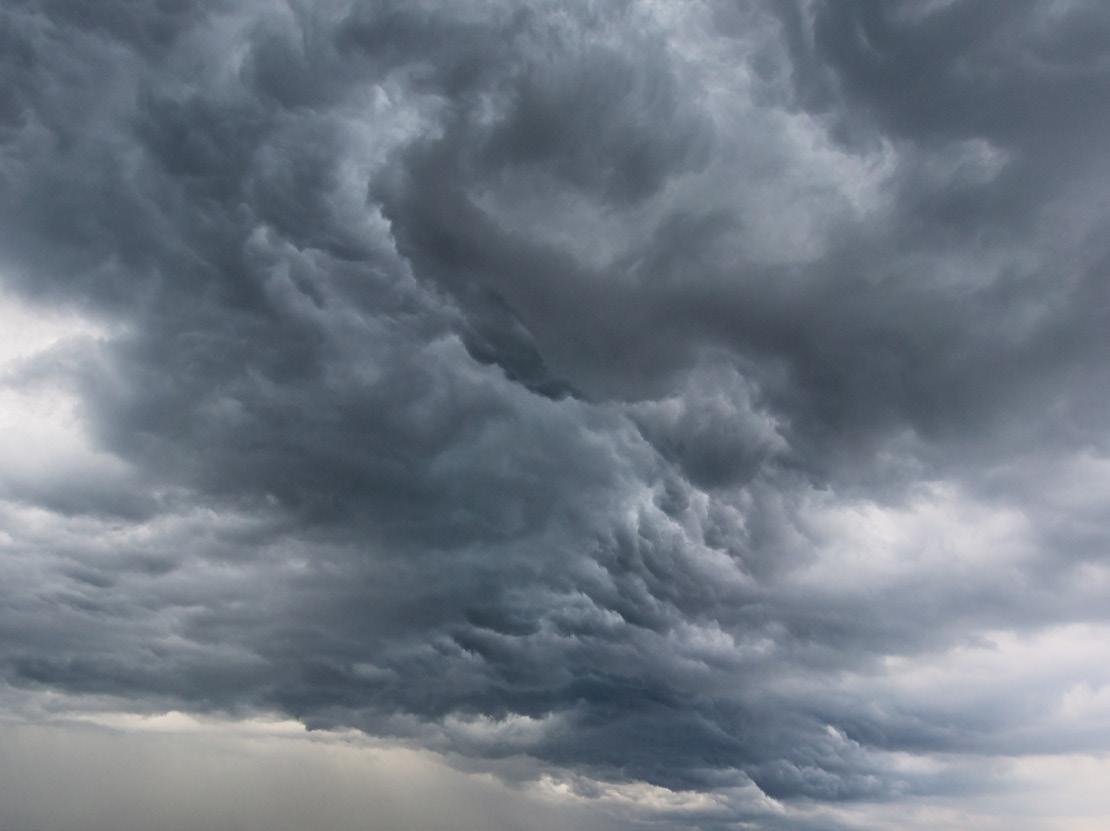
Learn from Jeremy Hance, visiting environmental journalist who spoke at a Weston Roundtable lecture in March.
By Chelsea Rademacher
If you’re reading this magazine, chances are you care about the environment. And if you care about the environment, you’ve probably felt some level of anxiety about our future as a species and a planet. The bad news? Well, it’s warranted. But the good news is that there’s still hope: not just for your mental health, but for the world.
In March 2024, environmental journalist Jeremy Hance came to the UW–Madison campus to speak at a Weston Roundtable lecture, hosted by the Nelson Institute’s Center for Sustainability and the Global Environment. In his talk,“Mental Carbon: The Toll of Climate Change on Our Sanity and What We Can Do About It,” Hance discussed the real drivers behind climate anxiety, its definition and degrees, and tools for coping.
Here are four things you might not have known about climate anxiety.
1. Climate anxiety has a definition. “A chronic fear of environmental doom,” Hance said. It can manifest as grief, despair, anxiety, and pessimism.
2. There are four levels of climate anxiety.
British psychotherapist Caroline Hickman breaks down climate anxiety into mild, moderate, signifiant, and severe. Those with moderate climate anxiety feel upset, but believe there are solutions. People with significant climate anxiety see a significant impact on their daily life, including feelings of guilt and grief. For people with severe climate anxiety, “You believe that society is doomed,” said Hance. This level of anxiety leads to intrusive thoughts, difficulty functioning, or even self harm.
“On a moderate level, this is a normal human reaction to the information that you are getting.”
— Jeremy Hance
3. Your climate anxiety is normal.
“On a moderate level, this is a normal human reaction to the information that you are getting,” Hance shared, compared to a pathological diagnosis of anxiety or depression. “It’s connected to reality.”
4. You can train yourself to be resilient. How? “It’s not exactly fun or easy,” said Hance. Step 1: Let the negative feelings in. “You have to allow yourself to feel the crap. You have to allow yourself to face what it is that you’re afraid of.” Step 2: Grieve the environment and climate you remember. “We are in a weird situation. We usually think of grief as a human-to-human thing. Someone dies, we grieve for them. We are in a situation now where we need to learn how to grieve for non-human things.”
Watch the full talk to learn more about the relationship between mental health and climate change — including more tools for managing climate anxiety.
The Weston Roundtable — a public lecture series and a 1-credit class made — is possible by a generous donation from Roy F. Weston, a highly accomplished UW–Madison alumnus. Designed to promote a robust understanding of sustainability science, engineering, and policy, these interactive lectures are cosponsored by the Center for Sustainability and the Global Environment, the Department of Civil and Environmental Engineering, and the Office of Sustainability.



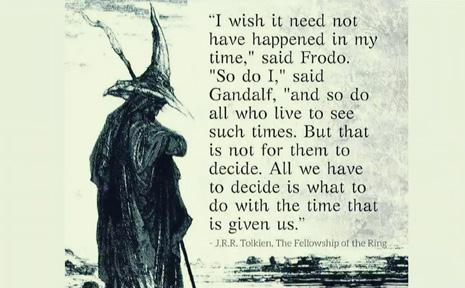
A winning essay from the 2023 Sustainability Writing Awards, hosted by the Office of Sustainability.
By Hailey SewellHailey Sewell (she/her) is a third-year undergraduate majoring in English (creative writing) and environmental studies with a certificate in sustainability. She is currently working alongside the Office of Sustainability and the Lakeshore Preserve in developing programs to connect students and staff to the natural environment around campus to benefit mental health. Hailey is also hoping to get more involved with the ASM Sustainability Committee’s education campaign, which is fighting for a mandatory sustainability course for incoming students. After college, she strives to inspire change through her art about global climate injustices and the need for rapid environmental policy.
During the winter of 2007-8, there was a total snowfall of more than 100 inches in the city of Madison. The biggest storm occurred just before the turn of the new year. I don’t recall the total inch count (I was only five). But it was the first snowfall I can remember. There was so much snow that neither of my parents went to work. My brothers and I went out every hour to shovel the drive, to not let it build up too much. It was this snowfall, that cold blanket of clouds, which birthed a poet from its frost. Layers of ice kiss the flowerbeds of dead brush, tucking it in like a child ready for bed. It was this storm that taught me a love for the outdoors even in nature’s harshest storms. And it was this storm that I decided never to leave the snow. I would stop time and live there forever.
I told myself I would bundle up every day. Be sent out and work in the bitter air, nose cold and socks wet, just to be in the wonderful gift that was snow. This was my dream.
Today, I often find myself thinking of the lack of these magical days. Being an adult isn’t very magical. It feels like there is less snow and the winters are shorter. There has been less magic, more conflict, politics, violence. I wonder if the child sitting at my elementary school desk will ever know about a snow day. A day when feet of snow pile up and hold them up inside their home. One
day they would smell cinnamon hot cocoa and sticky banana muffins made by their nana. Will they find the snow as magical as I did? I think of this when the fresh blankets fall. Then the snow comes to melt, and soon it is spring.
When the snow is still falling in January, I make resolutions. To use less single-use plastics. To completely

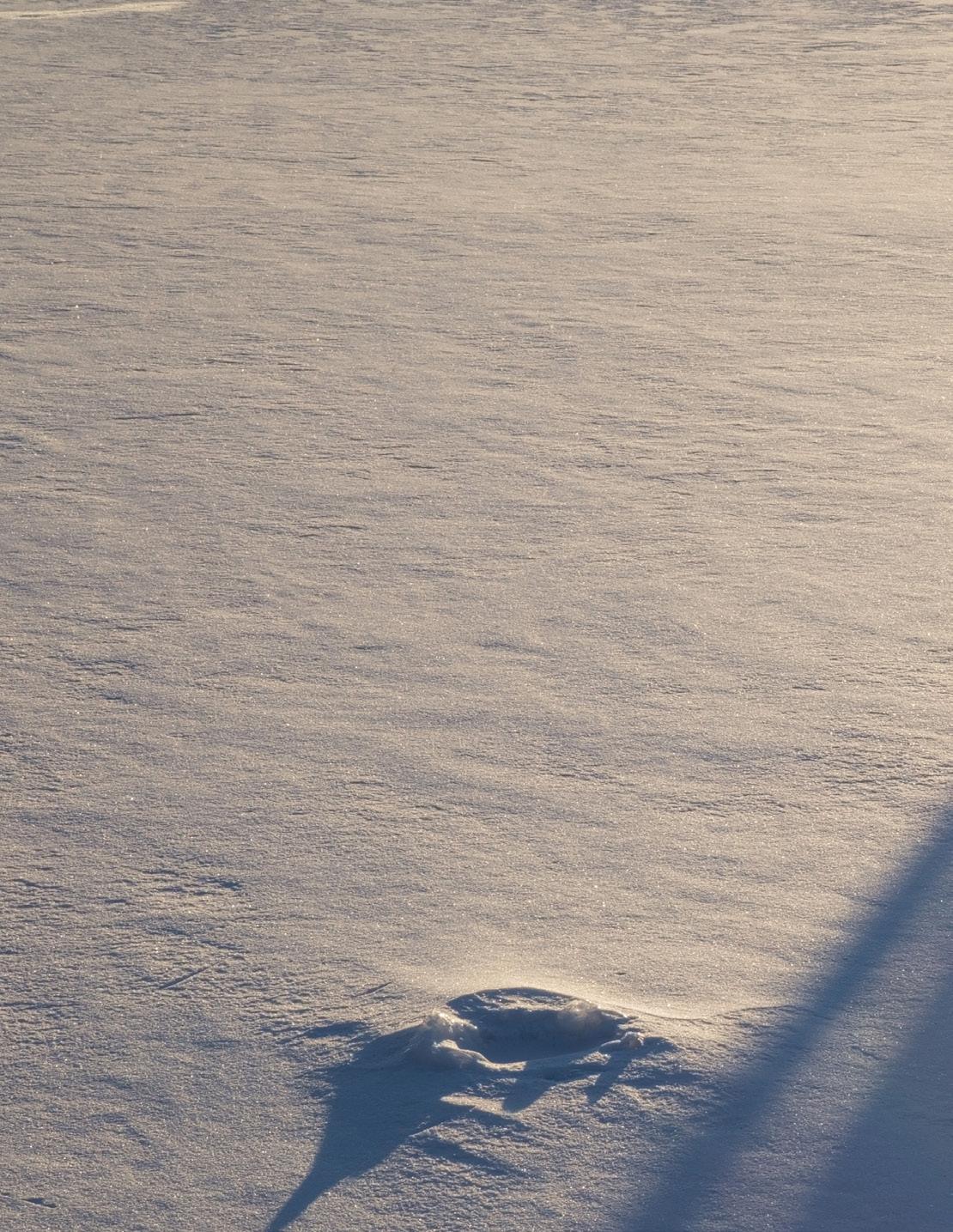
“Humanity has been sleeping for 270 years.”
— Hailey Sewell
cut dairy out of my vegetarian diet. To believe that the people I’m voting into office will follow through with promises. But just like all New Year’s resolutions–and most politicians–we do not follow through. Western society values wealth and convenience far more than the health of the natural world and those severely affected by an ever-changing climate. And without rapid social change, there will be no solution, there will be no more snow. Madison will begin to feel like St. Louis.
Humanity has been sleeping for 270 years. The stopwatch began with the Industrial Revolution, and year by year we do worse and worse. We rarely follow through with our New Year’s resolutions. Corporations make resolutions, too. They promise to “go green” by 2025, but that gets pushed back to 2050. Politicians promise less offshore fracking and more resources for renewable energy, but the guarantees never seem to happen. This will go on until someone holds them accountable. Efforts like the Kyoto Protocol have failed. Many of the countries who signed the Paris Agreement are not on track to lower emissions enough to avoid the inevitable. We will see more than a 1.5°C increase
in average global temperatures. We will then see drought, floods, rapidly rising sea levels, and the death of billions. These ideas sound morbid, impossible even! They are not. They are true. And they are coming.
I have learned more than I want to about humanity’s fate. About everywhere we went wrong and every time we had the chance to save ourselves, and every time we failed to do so. I imagine what this campus could look like in 175 years. When humanity is gone, and this university—twice as old as it is now—stands still. Wildlife that could survive the heat living in Bascom Hall, State Street desolate and covered in weeds. The day would come, and night would fall. All of our things would sit. Shell. Amazon. BP. And we justify supporting these companies and lifestyles because of convenience. When it becomes more convenient to surround your life with completely renewable energy, only then will you make the switch. Too many people can help bring change to environmental protection and policy. People with the privilege and economic stability to live more sustainably day to day. Those same people can be the start of a bigger movement to provide access to sustainable alternatives to every person (regardless of intersectionality). But we do nothing. And the people who are most concerned and who have the most knowledge of climate change—youth, indigenous communities, and women—are silenced and spoken over.
That snowfall in ‘07 opened my eyes to magic. As it fell silently, fascination flowered in me. Today, I wish I could write about snow, and the sea, and how excited I am to experience the wonders of life over and over again. But I cannot. Because without a resolution we can all agree upon, humanity will become obsolete. Our trees and rivers are crying, but because we cannot hear them, we walk by them without a second thought. There is no thank you card for the trees that are trying their best to take carbon out of the atmosphere, no nod of approval or acknowledgment of life. Only silence. And when the snow begins to fall and a new year comes about, humanity’s resolutions will include those of capitalism and greed rather than doing all we can to fix our mistakes. Corporations and politicians are washing our bodies with gasoline, and we are pushing ourselves closer and closer towards a flame. And although not everyone will burn at the same rate, there is no way to escape the mercilessness of nature.


Hear an interview with Sewell and the other awardees on the SustainUW Podcast.

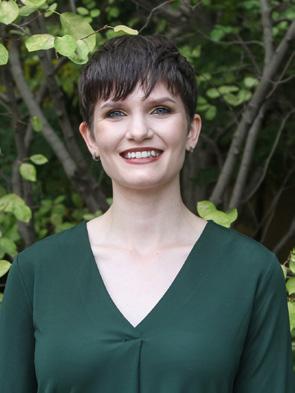
“After finding this WRM program and learning about its flexibility and professional focus, I knew it was exactly what I was looking for.”
– Alayne Kulp
On paper, Alayne Kulp seems to capture a typical Wisconsinite.
Grew up on a dairy farm? Check. Loves a good cocktail? Check. Friendly, hardworking, and down-to-earth? Check, check, and check.
Despite her Midwest typecast, Kulp has singled herself out through her passions for geography, hydrology, and water management, which began on her family’s dairy farm in Marathon County. “I grew up working on that farm and was schooled at home,” Kulp said, “so I gained a lot of experience about how a farm worked.”
For her undergraduate degree, Kulp majored in geography with an emphasis on geographic information systems (GIS) and added a professional and technical writing minor while at the University of Wisconsin–La Crosse. After graduating in 2018, she took a few years off to work in a fine dining restaurant, however, her goal was always to go back to school and earn her master’s degree, eventually prolonged from the COVID-19 pandemic.
After learning about the Nelson Institute’s water resources management (WRM) program, Kulp decided to enroll at the University of Wisconsin–Madison, her

“dream institution.” Coupled with the opportunity to learn more about some of her favorite topics, including river systems, landform processes, and watershed hydrology, Kulp was doubly excited to begin her master’s journey. “My main goal for my graduate school experience was to take more classes and gain hands-on experience in my areas of interest that my geography degree didn’t get to,” Kulp said. “After finding this WRM program and learning about its flexibility and professional focus, I knew it was exactly what I was looking for.”
The WRM program is a 45-credit professional master’s degree that prepares students to work in the complex world of water management and conservation. The program requires students to pick an area specialty to achieve competency in a particular water-related area and complete a summer practicum project focusing on a contemporary problem in water resources.
Starting the program in August 2023, Kulp notes one of her favorite classes so far being Community and Environmental Sociology 617: Community Development with Professor Randy Stoecker. The class focuses on the social, cultural and personality factors that influence community development while referencing developing countries and rural communities. “For me, it served as an introduction to how sociologists and planners look at communities and the problems that they face. I was able to learn about the urban and regional planning side of things which has really influenced my area specialty as well,” she said.
Kulp’s area specialty focuses on watershed science and planning, which she intends to add a double degree in urban and regional planning to support. “It’s one of those things where the more classes I take, the more I want to learn and do,” Kulp laughed. She aspires to turn her specialty into a career as a science-informed water-
shed resource planner and hopes to work in both urban and rural areas, especially in Wisconsin.
For Kulp’s summer practicum project, her cohort was directed to collect data to document the pre-restoration conditions of a planned stream restoration project in the Fancy Creek Watershed in Richland County. “It’s an area of the state where there’s a lot of work to be done and things to learn, and it’s exciting to be able to see all the opportunities that it provides,” Kulp said. “One thing I really like about this project is that our work will support those involved in the restoration and will have an impact on a rural watershed that includes a valuable wetland ecosystem.”
“One thing I really like about this project is that our work will really matter and will have an impact on a rural wetlands area.”
– Alayne Kulp
Looking back at her experience so far, Kulp praises the people who have helped her in her journey, including WRM program chair Ken Genskow and graduate advisor Jim Miller, who were instrumental in helping guide and advise her. She advises future students to “be a sponge” and soak up as much knowledge as possible through professors, advisors, and other students. “Listen to those around you about what they’ve learned and be open to any information that comes your way,” Kulp concluded.
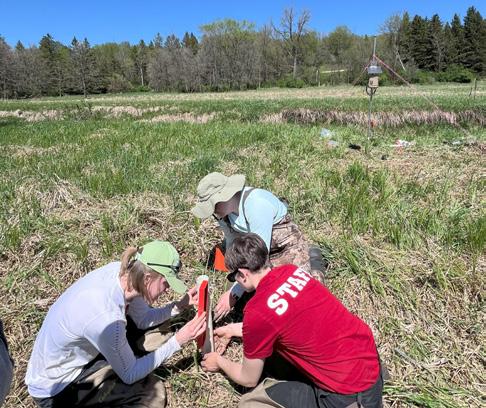
Nina Delgadillo translates her experience at the Office of Sustainability to the Milwaukee Water Commons.
By Chandler Wells, Office of Sustainability
by

This article was originally published by the Office of Sustainability’s “Where Are They Now?” series, in which current student interns interview former interns about their experience at the Office of Sustainability, particularly how that experience has helped them since graduation. In the following entry, Chandler Wells relates her conversation with Nina Delgadillo.
During the Water @ UW Conference in the spring of 2023, Nina Delgadillo found herself among a diverse group of academics, researchers, and community leaders from local environmental organizations. Representing the Office of Sustainability (OS), Delgadillo delivered a lightning talk titled “From the classroom to the community: The importance of student involvement in social sustainability.” It was during this conference that Delgadillo crossed paths with the director of programming at the Milwaukee Water Commons, sparking a connection that would ignite her professional journey.
After graduating from UW–Madison in May of 2023, Delgadillo landed a position as the digital communications coordinator at the environmental nonprofit based in Milwaukee. The City of Milwaukee faces various water-related challenges, including issues with lead pipes in older homes and limited beach access, particularly in the neighborhoods historically marginalized by segregation. Delgadillo’s role at Milwaukee Water Commons involves crafting monthly newsletters, updating event calendars, conducting community outreach, and managing their social media account to showcase ongoing policy efforts, events, and initiatives affiliated with the organization.

“We work closely with the community to ensure that every single Milwaukee resident knows what it’s like to have access to safe, clean water,” said Delgadillo, highlighting the organization’s mission.
The Milwaukee Water Commons collaborates with community partners, other nonprofit organizations, and the City of Milwaukee to prioritize equitable access to clean water. Delgadillo underscored the organization’s commitment to community engagement, noting that environmental initiatives should make a greater effort to involve input from local residents. She pointed out that the Milwaukee Water Commons is dedicated to its Water City Agenda, consisting of six key initiatives, including Branch Out Milwaukee, which focuses on tree maintenance to preserve water quality. As part of her role, Delgadillo engages with residents about the importance of healthy trees in their neighborhood and uses the Milwaukee Water Commons’ digital platform to ensure residents’ voices are acknowledged.
Delgadillo brings a unique perspective to her communications role,
emphasizing the importance of storytelling in addressing environmental issues.
“We often focus on numbers and data, but it’s crucial to highlight the lived experiences of people,” she said.
Delgadillo attributes her interest in environmental communications to her numerous experiences at UW–Madison. She interned with the OS for two years until her graduation in May 2023, earning a BS degree in environmental sciences and conservation biology, along with a sustainability undergraduate certificate from the Nelson Institute. During her time as an intern, Delgadillo served on the Green Athletics, communications, SSC, and UW Zero Waste Teams.
Delgadillo reflected on her time as an intern, recognizing that “OS staff create a safe and welcoming environment for interns to learn and grow” and that the student intern program provided many professional development opportunities.
Among the many opportunities at the OS, Delgadillo highlighted the skills she acquired in event planning. During her time with the communications team, she played a key role in coordinating events for Earth Week and Sustaina-Bash, gaining essential skills in goal-setting and implementing effective strategies for campus engagement. One of her favorite projects with the OS was conducting waste audits with Green Athletics, where she gained firsthand experience in waste management operation.
Delgadillo also emphasized the influential role of her undergraduate research position at UW–Madison, encouraging students to “find a research opportunity that aligns with your niche.”
During her junior year at UW–Madison, Delgadillo tapped into the resources of the UW–Madison research portal, contacting professors and offering her assistance with their research endeavors. She was fortunate to connect with Nelson affiliate Caroline Gottschalk Druschke, contributing to the ongoing community-based research by conducting interviews with residents of the Kickapoo and Coon Creek watersheds for the Learning to Make Running Water Walk oral narrative project.

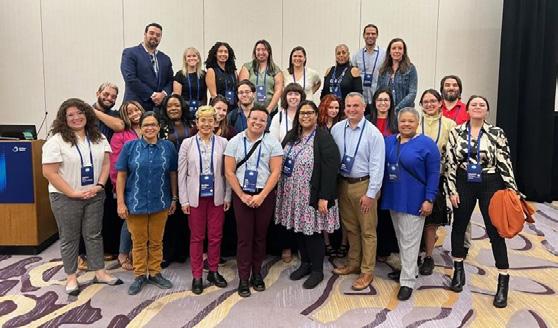
Delgadillo’s career advice extends beyond standard strategies for job applications; it encourages students to recognize their intrinsic value beyond the confines of their academic qualifications.
“When applying for jobs, remember that you are an asset,” Delgadillo said. “You have unique skills, hobbies, and passions — and you are more than just your degree.”
This philosophy resonates with her own professional journey. Delgadillo’s dedication to sustainability and social justice did not go unnoticed by the hiring committee at the Milwaukee Water Commons, who recognized and valued her commitment to advancing social sustainability. From struggling to launch SSC’s Amplifying BIPOC Voices in Sustainability Series to witnessing its successes in campus engagement, Delgadillo learned the power of persistence and passion.
“Don’t let these passions slip away,” she said. “Show people your passions, and they will be more than willing to teach you new things as well.”
Please join us in welcoming the Nelson Institute’s new director of development.
On May 13, the Nelson Institute and the Wisconsin Foundation and Alumni Association (WFAA) welcomed Karen Anderson as the newest director of development.
An alumna of UW–Madison and the Nelson Institute, Anderson earned her undergraduate degree in biology with a certificate in environmental studies, followed by a master’s degree in the Nelson Institute’s water resources management program. During her time as a student, Anderson was a Nelson student representative (now the Nelson Ambassadors program) and treasurer of Environment on Tap, an informal discussion series cohosted by Nelson and local brewery Ale Asylum.
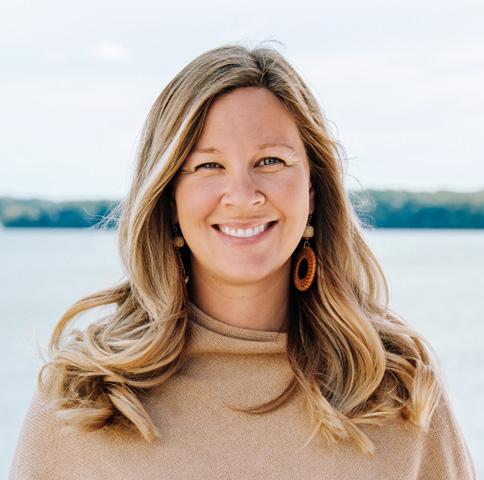
Anderson brings a background in conservation biology and a decade of fundraising experience to her role as Nelson’s development director. Previously, she worked as a conservation biologist and restoration specialist with the Prairie Enthusiasts, State of Wisconsin, and the Lac du Flambeau Tribe. Most recently, Karen was the director of development for the River Alliance of Wisconsin, a Madison-based nonprofit that empowers people to protect and restore our waterways.
“As a Nelson water resources management alum, I am grateful for the opportunity to come full circle and help philanthropists support research that transcends disciplinary boundaries, experiential education that bridges classrooms and communities, and cross-sector public programs. Please drop me a line and let’s connect!
Email: karen.anderson@supportuw.org ”
Interested in supporting the Nelson Institute?
There are many ways to contribute to the Nelson Institute — participating in our events, mentoring our students, providing connections to your personal networks, and making financial gifts. All of these are necessary and important to us, and we invite you to invest in our community in the way that makes the most sense to you.
Learn more about all of the great academic programs, research centers, and public programs we offer.
in any amount are needed and appreciated!
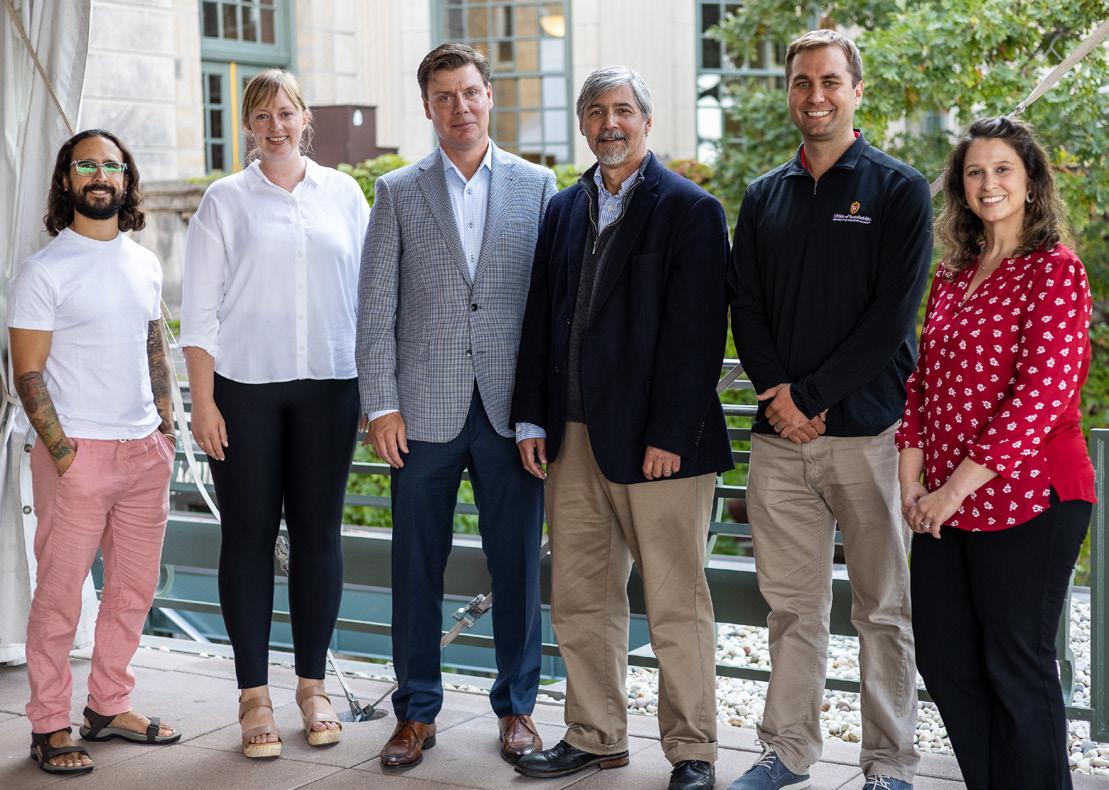

Don’t miss this chance to reconnect with your fellow Nelson Institute alumni, meet current students and faculty, and of course, enjoy a sunset over Lake Mendota. Registration and more information coming soon!


